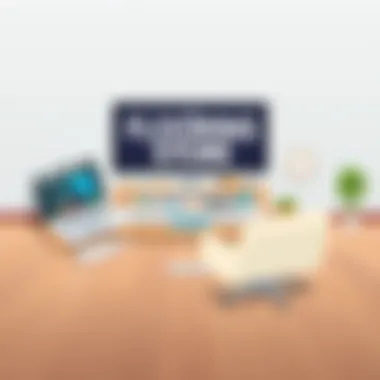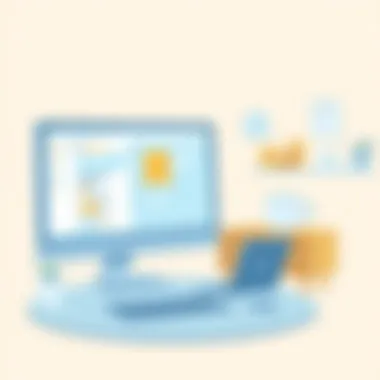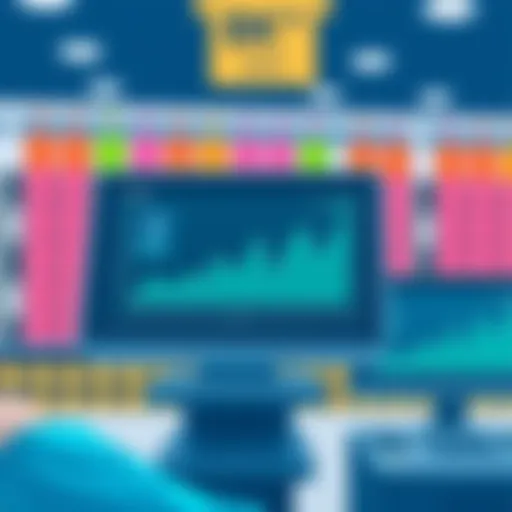Comprehensive Guide to Flooring Store Software


Intro
In an era where efficiency dictates the pace of business, flooring retailers are increasingly leaning on technology to streamline their operations. Flooring store software has emerged as a vital component, aiding businesses in managing everything from inventory to customer relationships. As decision-makers weigh their options, understanding the capabilities and nuances of such software becomes essential. This examination will clarify how these tools can reshape floors retailers' operational landscape, modernizing practices that may have remained stagnant in the past.
Key Features and Functionalities
Comprehensive Overview
Flooring store software is designed with a variety of features that cater specifically to the needs of the flooring industry. These tools aren’t just mere digital assistants; they play a crucial role in optimizing processes. Some key features include:
- Inventory Management: A real-time oversight of stock levels, helping prevent overstocking or stockouts.
- Customer Relationship Management (CRM): Tools that allow businesses to track customer interactions and preferences, enhancing service and personalizing the buying experience.
- Sales Analytics: Reports and dashboards that help retailers understand sales trends, allowing for more informed decision-making.
- Order Processing: Streamlined procedures for managing purchases, from initial quotation to final sale, ensuring a smoother customer journey.
- Multi-Channel Integration: Abilities to sync operations across various platforms, whether online or brick-and-mortar, fostering a unified experience.
"Investing in flooring store software isn't just about keeping up; it's about staying ahead of the curve in a rapidly evolving market."
Target Users
While the software is primarily targeted towards flooring retailers, its user base can be quite diverse. Below are some potential users:
- Small to Medium-Sized Retailers: Those seeking to enhance their operational capabilities without overspending.
- Large Enterprises: Businesses requiring advanced functionalities that integrate seamlessly with their existing systems and offer expansive reporting.
- Sales Representatives: Individuals who benefit from easy access to product information and inventory levels while on the go.
- Warehouse Managers: Staff responsible for stocking and managing inventory who rely on precise data to operate efficiently.
Pricing Models and Cost Analysis
Breakdown of Pricing Tiers
Understanding the cost structure of flooring software is as essential as recognizing its features. Typically, software for flooring stores may offer several pricing tiers to accommodate various budgets and business needs:
- Basic Plans: Ideal for startups, featuring essential functionality like inventory tracking and basic reporting.
- Standard Plans: Often include CRM capabilities and enhanced analytics, marketed towards mid-sized businesses looking for more robust features.
- Premium Plans: Comprehensive solutions with all features inclusive, aimed at larger enterprises or those with complex operational demands.
Additional Costs to Consider
In addition to subscription fees, there may be several other costs that retailers need to keep in mind:
- Setup and Implementation Fees: Costs associated with integrating the software into existing systems.
- Training Expenses: Investment in teaching staff how to use the new system efficiently.
- Maintenance Fees: Ongoing costs to keep the software updated and running smoothly.
- Third-Party Integrations: Potential extra charges for connecting the software with other platforms like e-commerce sites or accounting software.
Preface to Flooring Store Software
In today’s rapidly evolving retail landscape, flooring store software emerges as a critical piece of the puzzle for businesses looking to enhance their operational capacity and customer engagement. This software streamlines various aspects of running a flooring retail business, from managing inventory to processing sales and maintaining customer relationships.
The flooring industry, like many others, must adapt to changing consumer preferences and advances in technology. In this environment, flooring store software acts as a backbone that supports these businesses in navigating complexities with ease. By integrating advanced technological solutions, store owners can not only keep their heads above water but also thrive in a competitive market.
What is Flooring Store Software?
Flooring store software is a specialized tool designed to assist retailers in managing daily operations related to selling flooring products. It encompasses a wide range of functionalities tailored to meet the unique requirements of flooring retailers. Unlike generic retail software, this software typically includes features that account for specifics like different material types, pricing structures, and installation services, which are integral to how flooring retailers operate.
At its core, flooring store software enables streamlined inventory tracking, automates sales processes, and fosters strong customer relationships. More than just an operational tool, it often serves as a central hub for data analysis, helping business owners make informed decisions based on real-time insights.
Importance in the Flooring Industry
The significance of flooring store software cannot be overstated. As the flooring market continues to grow, driven by advancements in material technologies and changing consumer tastes, retailers need robust systems to remain competitive. Here’s why its importance shines brightly:
- Improved Efficiency: By automating routine tasks, the software minimizes human error, speeds up transactions, and enhances the overall efficiency of store operations.
- Enhanced Customer Experience: Happy customers are repeat customers. With tailored customer relationship management features, businesses can track preferences and histories, offering personalized service that creates loyalty.
- Data-Driven Decisions: Access to comprehensive reporting and analytics components empowers flooring retailers to make strategic choices grounded in solid data rather than guesswork. This leads to smarter inventory management and better understanding of market trends.
- Adaptability to Market Changes: With fluctuating trends and economic uncertainty, having a flexible software solution allows businesses to adjust quickly to new demands, whether that means adding new products or rethinking services to meet customer needs.
"In a world driven by data and customer experience, flooring store software is not just a luxury—it's a necessity for survival and growth in the industry."
Given these factors, it's clear that flooring store software plays a pivotal role in shaping how businesses operate in today’s marketplace. It provides the necessary tools and insights that empower decision-makers, IT professionals, and business owners to navigate challenges efficiently and strategically.
Key Features of Flooring Store Software
When it comes to flooring store software, the proverbial devil is in the details. The core features of such software play a pivotal role in determining how effectively a flooring retailer can operate. Given the complexities inherent to inventory, customer management, and sales processing, a comprehensive understanding of these features becomes paramount for decision-makers and IT professionals alike. By focusing on the essential aspects of flooring store software, businesses can enhance their operational capabilities, thereby driving customer satisfaction and ultimately increasing their bottom line.
Inventory Management
An effective inventory management system is essential for flooring retailers, ensuring that stock levels are appropriately maintained and that the right products are available when customers walk through the door. Such software allows for real-time tracking of inventory, which helps in forecasting demand and minimizing overstock or stockouts. Moreover, functionalities like automated reordering can signal when materials need to be replenished without constant manual oversight. This not only saves time but also reduces human error.
With various flooring types — from hardwood to tile — spanning across numerous colors and styles, a robust inventory system can categorize these items efficiently. Customizable tags or categories make it easier for sales staff to navigate the inventory and assist customers with ease. In essence, good inventory management can streamline both the purchasing process for customers and the operational workflow for staff, providing a seamless shopping experience.
Sales Processing


Sales processing is the heartbeat of any retail operation. The flooring store software must facilitate smooth transactions, whether they’re in-store or online. This includes everything from point-of-sale functions to the integration of payment gateways. A user-friendly interface can make transactions quick and hassle-free, significantly improving the customer experience.
Additionally, many retail operations face unique challenges such as split payments or financing options. Flooring store software can streamline these processes, enabling customers to explore their purchasing options without friction. By providing multiple payment methods, including credit cards, mobile payments, or even financing plans, retailers cater to a broader range of customer needs, thus expanding their sales potential.
Customer Relationship Management
In any retail sector, nurturing customer relationships is key. Flooring store software typically comes equipped with customer relationship management (CRM) features that empower staff to track interactions with clients effectively. This not only involves capturing basic information, like contact details, but also managing customer preferences, purchase histories, and even follow-up reminders for service or maintenance.
A savvy CRM system assists in generating personalized messages or offers, which can enhance customer loyalty significantly. For instance, if a customer previously purchased laminate flooring, the system may suggest complementary products such as underlayment or warranties when they return. This level of personalized service can foster long-term relationships, boosting repeat business and encouraging word-of-mouth referrals.
Reporting and Analytics
Finally, the analytical capabilities of flooring store software cannot be overstated. The reporting tools empower decision-makers to extract actionable insights from sales data, inventory levels, and customer behaviors. Identifying trends can inform better stocking strategies or marketing efforts.
For example, if data shows a spike in demand for a specific type of carpet during certain months, retailers can preemptively increase their stock to meet this upcoming demand. Furthermore, performance metrics can highlight which products are underperforming, providing retailers with the necessary information to adjust their strategies accordingly. By leveraging analytics, businesses can make data-driven decisions that steer them toward success.
"A comprehensive flooring software system is not merely a tool but a vital partner in navigating the intricacies of retail management."
In summary, the key features of flooring store software can be transformative. From efficient inventory management to insightful reporting, these elements work in harmony to refine operations and strengthen customer relations, making them indispensable in today’s competitive flooring market.
Benefits of Implementing Flooring Store Software
Implementing flooring store software is not just a passing trend; it is shaping the industry and influencing how businesses operate daily. The benefits derived from such software can be immense, ranging from heightened operational efficiency to strengthened customer relationships. The flooring industry is unique, and the right software adapts to its nuances while driving performance. Here’s a closer look at why flooring store software is indispensable.
Enhancing Operational Efficiency
Operational efficiency is where flooring store software truly shines. Imagine a bustling store, customers milling about, and a multitude of tasks at hand. This is where automation comes into play, allowing tasks such as inventory tracking and sales processing to run smoothly. With real-time data, staff can avoid running out of stock or over-ordering—both scenarios can hit a business hard.
For instance, take a small family-owned flooring business that implemented specialized software. The result? They trimmed their ordering mistakes by almost 30%, translating into significant cost savings.
- Automation: Routine tasks are automated, freeing up employees to focus on customer interaction and service.
- Inventory accuracy: Real-time tracking reduces discrepancies, ensuring that what the store claims to have in stock aligns with reality.
Such enhancements not only streamline operations but also provide a competitive edge in a tight market.
Improving Customer Experience
When it comes to retail, customer experience is paramount. Flooring store software enhances this aspect in several ways. A well-integrated point of sale system, for example, can speed up transactions, meaning customers aren't left waiting in long lines. Easy browsing of products becomes a breeze, enabling customers to find exactly what they need without hassle.
In a case in point, a flooring chain adopted a customer management system that tracked buying habits. By understanding preferences and past purchases, they felt more personal communication could be established, leading to repeat business and satisfied customers.
- Personalization: Tailored product recommendations based on prior purchases can delight customers.
- Enhanced communication: Automated follow-up emails post-purchase can improve long-term engagement and satisfaction.
Thus, in pivoting towards the customer experience, flooring store software cultivates loyalty and repeat business—two important drivers of growth.
Facilitating Data-Driven Decisions
Data is often touted as the new oil, and for good reason. Flooring store software provides invaluable insights through reporting and analytics features. Decision-makers can evaluate sales trends, optimize pricing strategies, and understand customer behavior better than ever.
A flooring retailer once struggled with identifying seasonal sales patterns. By utilizing reporting features from their new software, they discovered that certain products were more popular during specific months of the year. This knowledge allowed them to align their marketing strategies accordingly, increasing sales by 20% during key periods.
- Sales trends analysis: Identify which products fly off the shelves and which ones linger.
- Forecasting: Anticipate trends in customer preferences to adjust inventory and promotions ahead of time.
In this landscape, being informed translates to being effective. Flooring store software arms businesses with necessary insights for informed, strategic decisions.
"The right flooring store software doesn’t merely improve operations; it transforms the entire way a business interacts with its customers and its bottom line."
Integrating flooring store software is an essential step as the industry continues to evolve. The advantages outlined here not only demonstrate the importance of implementation but also spotlight the tangible benefits that can redefine success in the flooring retail sector.
Choosing the Right Flooring Store Software
Selecting the appropriate flooring store software is not just a choice; it's a strategic move that can define the success trajectory of a business. In a sector where speed, efficiency, and customer satisfaction reign supreme, having the right software can mean the difference between thriving or merely surviving. Understanding the software landscape provides decision-makers with the necessary tools to elevate their operations to the next level.
When you're sifting through options, it’s crucial to grasp the various elements that contribute to effective software selection. Each flooring business has unique needs based on size, market strategy, and customer base. Therefore, aligning the software’s capabilities with these particular needs can optimize performance and enhance service offerings.
Factors to Consider
When narrowing down the software options available, a few key elements should be at the forefront of your decision-making process:
- User-Friendliness: The software must be intuitive for your team to navigate smoothly. A steep learning curve can disrupt workflow.
- Scalability: As your business grows, your software should evolve too. Ensuring that your software can accommodate growth without requiring a complete overhaul saves time and money.
- Integration Capabilities: Your new flooring store software should integrate seamlessly with existing systems. Ensuring compatibility minimizes disruption and maximizes productivity.
- Customization Options: Flexibility is vital. Tailoring software functionalities to fit your specific needs can greatly increase operational efficiency.
Each of these aspects plays a pivotal role in ensuring that the program meets current demands while being adaptable for the future.
Budgeting and Cost Analysis


Navigating the financial terrain is perhaps one of the most critical steps in choosing flooring store software. Establishing a clear budget not only helps in eliminating options but also sets realistic expectations about what can be accomplished.
- Initial Costs: Consider not just the upfront purchase price but any installation fees or onboarding costs that may accrue.
- Ongoing Fees: Subscription models or licensing agreements may create additional financial obligations over time. Make a budget that includes potential recurring costs.
- Hidden Costs: Look out for expenses like upgrade fees, additional feature costs, or service charges that might not be immediately obvious.
Taking a hard look at these financial components ensures you're making a well-informed investment instead of entering a potential financial pitfall.
Vendor Reputation and Support
The vendor of your flooring store software plays a significant role in how you experience the product over time. Choosing a reputable vendor can enhance your operational success and provide peace of mind as you navigate through challenges.
- Research Vendor History: Look into their track record. Have they supported previous clients successfully? Feedback and reviews are goldmines of information.
- Customer Support: Ensure that the vendor offers robust support, including training, troubleshooting, and ongoing assistance. A responsive support team can stave off numerous headaches.
- Community Engagement: Vendors with an active user community or forums can be beneficial resources for real-world problem-solving and tips.
Overall, aligning yourself with a solid vendor can make the complexities of flooring store software implementation much smoother.
"Choosing the right flooring store software is essential for a business to stay nimble in a constantly shifting market."
When these factors, budgeting strategies, and vendor assessments coalesce, flooring businesses position themselves not only to choose software that addresses their current requirements but also builds a foundation for long-term success. This conscious selection process promises not just better day-to-day operations but ultimately elevates the customer experience, laying the groundwork for sustainable growth.
Integration with Existing Systems
In today’s fast-paced flooring retail landscape, integrating flooring store software with existing systems is more critical than ever. This aspect affects not just the software adoption rate but also how businesses streamline operations and maximize productivity. It’s not just about smooth operation; it’s about making the most out of the tools already in place, ensuring they communicate effectively with new software to create an ecosystem that thrives.
Compatibility with Other Software
When evaluating flooring store software, one significant consideration is compatibility with other software systems already in use. Many businesses operate with a variety of applications, whether for accounting, inventory management, or customer relationship management. Ensuring that new flooring software can seamlessly interface with these systems can prevent disruptions in operations.
- For instance, integrating Point of Sale (POS) systems like Square or Clover can facilitate real-time sales tracking and inventory management.
- Using software that is compatible with the existing accounting applications simplifies financial reporting, allowing for automatic data flow without manual entry.
- Additionally, sync-up with online platforms like QuickBooks can ease the transition between sales and accounting processes.
In effect, this compatibility reduces errors and maximizes operational efficacy, which translates into higher productivity.
Data Migration Strategies
Engaging in data migration strategies is another pivotal element when integrating flooring store software. Moving existing data to a new system can be daunting if not properly addressed. A hasty or careless migration can result in lost sales records, client information, or product details—essentially throwing a wrench into seasonal promotions or customer interactions.
To achieve a successful data migration, several strategies can be employed:
- Planning and Mapping Existing Data: Understand what data needs to be migrated and outline the structure of how it will fit into the new software’s schema. Some elements might require cleaning or restructuring.
- Utilizing Migration Tools: Many software vendors offer built-in migration tools that can facilitate this process. It’s key to leverage these instead of a manual transfer.
- Testing and Verification: After migration, conduct a thorough audit to ensure that no data is missing and everything is functioning as it should. Testing ensures that the software is apt for everyday usage and can handle various scenarios.
- Continuous Backup: Always keep backups of the original data before initiating migration. This way, in the event of failures or unexpected issues during the transfer, a fallback option exists.
Getting the data migration right is essential for a smooth transition, fostering trust and confidence in the new system.
"Investing in flooring store software that integrates well with existing systems is not just a choice; it’s a strategy that sets the foundation for long-term success."
In summary, integration with existing systems, compatible software options, and robust data migration strategies are vital for flooring store software. Each layer enhances overall business performance, minimizes risk, and ultimately supports the overarching goals of operational efficiency and elevated customer satisfaction.
For more insights on software integration topics, consult resources like Wikipedia or check discussions on Reddit.
Considering these factors leads flooring retailers toward informed choices that optimally align their technology stack with business objectives.
Trends in Flooring Store Software
The landscape of flooring store software continues to evolve, largely driven by advancements in technology and shifting consumer expectations. Understanding these trends is crucial for flooring retailers looking to maintain a competitive edge. By embracing innovation, businesses can not only streamline their operations but also significantly enhance customer satisfaction. Moreover, staying in tune with industry developments helps decision-makers anticipate future needs and adapt proactively.
Artificial Intelligence and Automation
Artificial Intelligence (AI) and automation are at the forefront of the transformation occurring in flooring store software. These technologies enable more efficient processes, reduce human error, and offer insights that can guide strategic decisions. Retailers can deploy AI-driven tools for various tasks, such as customer support via chatbots or advanced inventory management systems that predict stock requirements based on historical data.
Benefits of AI and Automation in Flooring Retail:
- Enhanced Customer Engagement: AI applications, including chatbots, help customers by answering inquiries and guiding them through product selections, thus improving their shopping experience.
- Streamlined Operations: Automation reduces the burden of manual tasks, such as data entry or invoicing, allowing staff to focus on more critical aspects of the business.
- Predictive Analytics: Retailers gain valuable insights into trends and customer behaviors, enabling them to make informed decisions about product offerings and marketing strategies.
The integration of AI is not without its challenges. Retailers need to ensure that their staff is trained to work with these tools effectively. Furthermore, ethical considerations around data privacy must be addressed to build and maintain customer trust.
Cloud-Based Solutions
Cloud-based solutions represent another significant trend within flooring store software. The shift to cloud computing offers flooring retailers numerous advantages, making operations more flexible and cost-effective. With cloud technology, businesses can store vast amounts of data securely and access it from anywhere, which is particularly valuable for multi-location retailers.
Advantages of Cloud-Based Flooring Store Software:
- Accessibility: Staff can access critical information from any location, facilitating remote work and multi-store management.
- Scalability: As businesses grow, they can easily scale their software solutions without the need for significant infrastructure investment.
- Automatic Updates: Cloud solutions usually provide regular updates automatically, ensuring that businesses are utilizing the latest features and security patches without disruption.
Implementing cloud-based systems, however, does require careful planning. Retailers must consider robust internet connectivity and ensure that they select reliable vendors with strong security protocols. Addressing these points can help mitigate potential risks and optimize the efficiency of cloud solutions.


In summary, the embrace of AI and automation alongside cloud-based solutions showcases how flooring retailers are innovating to meet the demands of an evolving marketplace. Those who successfully integrate these trends into their operations will likely reap substantial benefits in efficiency and customer satisfaction.
Case Studies: Successful Implementation
Understanding how flooring store software works in real-world scenarios illuminates its impact. Case studies serve as excellent tools to show not only functionality but also the benefits derived from successfully integrating software into flooring businesses. They highlight specific settings—from small enterprises to large retail chains—and illustrate how these businesses have transformed their operations. Such insights aid decision-makers in grasping the nuances of software adoption, including challenges faced along the way.
Small Business Example
Look at a quaint flooring shop in a tight-knit community. This small business had been utilizing manual methods for tracking inventory and sales—think a notepad for orders, and a calculator for profits. Not surprisingly, they experienced delays in fulfilling orders and stockouts that frustrated customers.
After researching various options, the owner decided to implement Flooring Max, a software specifically tailored for flooring retailers. The transition wasn't seamless; the staff needed training, and not everyone was on board at first. However, once they got the hang of it, they began to see significant improvements.
Key aspects of this implementation include:
- Improved Inventory Control: The new system automated stock tracking, which drastically reduced errors in inventory counts.
- Streamlined Customer Orders: Orders were processed more efficiently, leading to quicker delivery times and happier customers.
- Real-time Analytics: The owner could now access sales data at any given moment, enabling proactive decisions on restocking.
Within months, the business not only retained existing customers but also attracted new ones who appreciated the quicker service. Sales soared by 25%, proving the old adage: sometimes you have to spend a little to gain a lot.
Large Retail Chain Example
Conversely, let’s observe a large retail chain, Floor Palace, renowned across several states. With numerous stores and a vast array of products, their systems were bogged down by redundancy and inefficiencies, resulting in missed sales opportunities and customer dissatisfaction. Their existing software systems could hardly keep up with demand during peak shopping seasons.
The decision was made to implement Flooring Harmony, an enterprise-grade flooring store software capable of handling multiple locations seamlessly. The implementation process was conducted in phases, allowing each store to adapt without significant downtime, but challenges were still present.
The results were transformative:
- Centralized Inventory Management: Floor Palace eliminated excessive stock and maintained optimal inventory across its stores, reducing holding costs.
- Enhanced Customer Engagement: With integrated CRM features, the company was able to craft more personalized marketing campaigns, resulting in a notable uptick in customer loyalty.
- Comprehensive Reporting: Managers could analyze regional performance quickly, thus tailoring offerings that resonated with local customer preferences.
In the first year following the implementation, Floor Palace reported a 30% increase in overall sales and enhanced operational efficiency across the board. This case shows that even larger corporations can reap significant benefits from effective flooring store software.
"Success isn't just about what you accomplish in your life, it's about what you inspire others to do."
These case studies illuminate how different business sizes navigate the challenges of adopting flooring store software. The lessons learned here can guide both aspiring entrepreneurs and established retailers in making informed decisions, ensuring they find the perfect fit for their unique needs.
Common Challenges in Flooring Store Software
Implementing effective flooring store software is not just about choosing the right features or investing in the latest technology. It encompasses navigating several hurdles that could affect not just the adoption rate, but also any potential returns on investment. Understanding these challenges is vital for decision-makers and IT professionals striving for operational excellence in the flooring industry. This section sheds light on two major pillars of concern: user adoption issues and system reliability.
User Adoption Issues
User adoption is a thorny issue that can make or break the success of flooring store software. Technology is, at its core, a tool meant to enhance workflow, but if the team doesn’t engage with it, its effectiveness is diminished. It’s like investing in a premium set of golf clubs: if you don’t know how to swing them, your game won’t improve.
Implementing new software can often lead to resistance among staff, primarily because many may find it easier to stick with the old ways they are familiar with, rather than learn something new. Moreover, there can be a disconnect between the IT professionals rolling out the software and the day-to-day users who need it most. Bridging this gap is crucial.
To facilitate a smoother transition, consider the following strategies:
- Training and Support: Comprehensive training sessions can go a long way in easing anxieties. Employees should feel equipped to use the new software instead of grappling with confusion.
- Feedback Mechanisms: Establish channels for users to voice their concerns; sometimes, small tweaks based on user feedback can significantly enhance experience.
- Incentives: Offering small incentives for those who hit milestones or complete training modules can effectively motivate staff.
System Downtime and Reliability
The reliability of software systems cannot be overstated. If flooring store software experiences frequent downtimes or bugs, it becomes more of a liability than an asset. In a high-paced retail environment, every second of downtime translates to lost sales and a frustrated team.
Running a flooring business demands flexibility and promptness. Imagine a client walking into your store excited to purchase a new floor but waiting for minutes—perhaps even hours—while the system struggles to process their order. This not only affects sales but can also tarnish your store's reputation.
Key points to consider for ensuring reliability include:
- Choosing a Reputable Vendor: Go for established software solutions with proven track records in the flooring industry. Conducting thorough research and reading reviews can help identify potential red flags.
- Regular Maintenance and Updates: Just like checking the oil in a car, keeping your software updated prevents wear and tear. Regular maintenance helps ensure systems run smoothly and efficiently.
- Backup Solutions: Having a failover system or backup protocol can act as a safety net during unexpected downtimes. It’s always better to be safe than sorry.
In summary, addressing user adoption concerns and guaranteeing system reliability are foundational to the successful implementation of flooring store software. By proactively tackling these challenges, retailers can pave their way towards enhanced workflows, better customer experiences, and ultimately, improved profitability.
Future of Flooring Store Software
The landscape of flooring retail is evolving at a rapid pace, and the future of flooring store software plays a pivotal role in this transformation. As technology continues to advance, understanding its implications for store operations becomes paramount for decision-makers in the industry. This section delves into upcoming innovations and the necessity for adaptability in facing evolving market demands. The focus on software solutions that will shape the future is significant, as these tools not only improve operational procedures but also enhance customer engagement and satisfaction.
Innovations on the Horizon
The flooring industry is on the brink of several innovative breakthroughs that promise to redefine operational efficiency and customer interactions. Some of the noteworthy advancements include:
- Augmented Reality (AR): This technology allows customers to visualize how different flooring options would look in their homes before making a purchase. AR applications make it easier for customers to make informed choices, thus increasing the likelihood of a sale.
- Blockchain Technology: This can provide an airtight system for tracking products from source to store. It ensures transparency in supply chains, which can be a selling point for environmentally conscious consumers.
- Enhanced Data Analytics: Advanced analytics tools will empower retailers to sift through vast amounts of data to glean actionable insights. From understanding customer preferences to forecasting inventory needs, this innovation can significantly enhance decision-making effectiveness.
"Staying ahead of the tech curve gives retailers the leverage they need to outperform competitors and meet client demands."
As these technologies gain traction, flooring retailers need to be prepared not just to adopt them but to fully integrate them into their operational fabric. This integration is crucial to leverage the potential gains in efficiency and customer satisfaction.
Adapting to Evolving Market Needs
Market dynamics for flooring are continually shifting due to various factors, from economic fluctuations to changing consumer expectations. To remain competitive, flooring retailers must focus on agility and adaptability. Considerations include:
- Changing Consumer Behavior: Today's shoppers are more informed and expect personalized experiences. Flooring stores should exploit data analytics tools to adapt their offerings based on emerging trends from customer feedback.
- Sustainability: As eco-friendliness is increasingly on the radar of consumers, flooring stores should consider software that helps track and promote sustainable practices and products. Transparency in sourcing and eco-labeling can set brands apart.
- Omni-Channel Retailing: More customers are shopping online, and the line between digital and physical shopping experiences is blurring. Flooring store software should facilitate a seamless omni-channel approach, allowing customers to transition smoothly between purchasing avenues.















